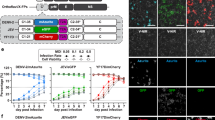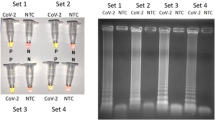Abstract
Since its first description 20 years ago, the tetrazolium-based colorimetric (MTT) assay using MT-4 cells for the detection of anti-HIV compounds has been widely used. This method, which remains popular, provides more information than more recently developed methods and, therefore, represents a useful methodology on its own or in combination with other screening systems. The replication of HIV in MT-4 cells is usually monitored 5 d after infection; therefore, this protocol can be divided into three steps: the infection (at day 0), an incubation period (5 d) and the evaluation (at day 5). The long-standing and intensive use of the MTT method has taught users of the limitations and, equally importantly, the unexpected advantages of the MT-4/MTT assay. The use of this method can be extended to antiviral testing of compounds against other cyto-destructive viruses.
This is a preview of subscription content, access via your institution
Access options
Subscribe to this journal
Receive 12 print issues and online access
$259.00 per year
only $21.58 per issue
Buy this article
- Purchase on Springer Link
- Instant access to full article PDF
Prices may be subject to local taxes which are calculated during checkout



Similar content being viewed by others
References
Nakashima, H. et al. Tetrazolium-based plaque assay for HIV-1 and HIV-2, and its use in the evaluation of antiviral compounds. J. Virol. Methods 26, 319–329 (1989).
Pauwels, R. et al. Rapid and automated tetrazolium-based colorimetric assay for the detection of anti-HIV compounds. J. Virol. Methods 20, 309–321 (1988).
Schols, D., Pauwels, R., Vanlangendonck, F., Balzarini, J. & De Clercq, E. A highly reliable, sensitive, flow cytometric/fluorometric assay for the evaluation of the anti-HIV activity of antiviral compounds in MT-4 cells. J. Immunol. Methods 114, 27–32 (1988).
Jordan, A., Bisgrove, D. & Verdin, E. HIV reproducibly establishes a latent infection after acute infection of T cells in vitro. EMBO J. 22, 1868–1877 (2003).
Kutsch, O., Benveniste, E.N., Shaw, G.M. & Levy, D.N. Direct and quantitative single-cell analysis of human immunodeficiency virus type 1 reactivation from latency. J. Virol. 76, 8776–8786 (2002).
Kutsch, O. et al. Bis-anthracycline antibiotics inhibit human immunodeficiency virus type 1 transcription. Antimicrob. Agents Chemother. 48, 1652–1663 (2004).
Miyoshi, I. et al. Type-C virus-producing cell-lines derived from adult T-cell leukemia. Gann Monogr. Cancer Res. 219–228 (1982).
Mosmann, T. Rapid colorimetric assay for cellular growth and survival: application to proliferation and cytotoxicity assays. J. Immunol. Methods 65, 55–63 (1983).
Scudiero, D.A. et al. Evaluation of a soluble tetrazolium/formazan assay for cell growth and drug sensitivity in culture using human and other tumor cell lines. Cancer Res. 48, 4827–4833 (1988).
Roehm, N.W., Rodgers, G.H., Hatfield, S.M. & Glasebrook, A.L. An improved colorimetric assay for cell proliferation and viability utilizing the tetrazolium salt XTT. J. Immunol. Methods 142, 257–265 (1991).
Dunigan, D.D., Waters, S.B. & Owen, T.C. Aqueous soluble tetrazolium/formazan MTS as an indicator of NADH- and NADPH-dependent dehydrogenase activity. Biotechniques 19, 640–649 (1995).
Salahuddin, S.Z. et al. Restricted expression of human T-cell leukemia–lymphoma virus (HTLV) in transformed human umbilical cord blood lymphocytes. Virology 129, 51–64 (1983).
Bjorndal, A. et al. Coreceptor usage of primary human immunodeficiency virus type 1 isolates varies according to biological phenotype. J. Virol. 71, 7478–7487 (1997).
Baba, M., Miyake, H., Okamoto, M., Iizawa, Y. & Okonogi, K. Establishment of a CCR5-expressing T-lymphoblastoid cell line highly susceptible to R5 HIV type 1. AIDS Res. Hum. Retroviruses 16, 935–941 (2000).
Reed, L.J. & Muench, H. A simple method for estimating fifty percent endpoints. Am. J. Hyg. 27, 493–497 (1938).
Acknowledgements
We thank Mrs Kristien Erven for critical reading and fine editorial assistance.
Author information
Authors and Affiliations
Corresponding author
Rights and permissions
About this article
Cite this article
Pannecouque, C., Daelemans, D. & De Clercq, E. Tetrazolium-based colorimetric assay for the detection of HIV replication inhibitors: revisited 20 years later. Nat Protoc 3, 427–434 (2008). https://doi.org/10.1038/nprot.2007.517
Published:
Issue Date:
DOI: https://doi.org/10.1038/nprot.2007.517
This article is cited by
-
Multiplexed multicolor antiviral assay amenable for high-throughput research
Nature Communications (2024)
-
Discovery of diarylpyrimidine derivatives bearing piperazine sulfonyl as potent HIV-1 nonnucleoside reverse transcriptase inhibitors
Communications Chemistry (2023)
-
Cardiotoxicity of cyclophosphamide’s metabolites: an in vitro metabolomics approach in AC16 human cardiomyocytes
Archives of Toxicology (2022)
-
Development and Evaluation of Peptide-Functionalized Gold Nanoparticles for HIV Integrase Inhibition
International Journal of Peptide Research and Therapeutics (2019)
-
Accessing chemical diversity from the uncultivated symbionts of small marine animals
Nature Chemical Biology (2018)
Comments
By submitting a comment you agree to abide by our Terms and Community Guidelines. If you find something abusive or that does not comply with our terms or guidelines please flag it as inappropriate.



